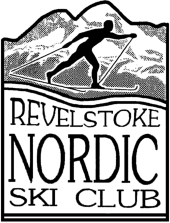RNSC Ski League
Clothing & Equipment
Clothing
Layers are the key to dressing for cross-country skiing. Layers provide the flexibility to adapt clothing according to the needs of the day. An enthusiastic skier can generate a great deal of body heat and perspiration even on the coldest days, so it is important to be dressed in such a way that allows excess heat and moisture to dissipate away from the body. These layers can be removed or replaced at will, even while on an outing. The layer next to the skin should be made from a material (polypropylene or wool) that keeps moisture and perspiration away from the skin and retains its insulating qualities when wet (avoid cotton).
Tops: A polypropylene shirt covered by a polar fleece sweater and a windbreaker or light insulated jacket is quite warm, allows excess heat and moisture to escape, and repels the snow.
Bottoms: Instead of insulated snow-pants, light wind-pants or rain-pants over one or two thin layers of polypropylene or polar fleece, will provide sufficient warmth, freedom of movement, and repel the snow.
Head: There is potential for great heat loss through the head. A warm polar fleece, light synthetic, or wool toque that protects all of the ears is essential. Headbands or buffs can be worn on warmer days.
Hands & Feet: Hands are the first body part to become uncomfortable in the cold, so a good pair of gloves or mitts is critical. Many use shelled Thinsulate or polar fleece liners with a water repellent/waterproof shell. Bringing a spare pair along on an outing is good insurance in case the first pair gets wet from making too many snowballs! Proper socks are important for warm feet (avoid cotton). A wool blend with polypropylene or some other synthetic is ideal.
Eyes: A comfortable pair of uv-protective eyewear is an important element of the cross-country skier’s gear. Interchangeable lensed sunglasses or economical protective eyewear are important to protect from UV and sharp pole tips! (UVEX and MEC carry good options).
Boots & Bindings
SNS and NNN are the two most commonly used boot/binding systems. Both are good and equally functional. Boots must be comfortable. If they are too large they will be awkward to ski in and if they are too small, the child’s feet will not stay warm. To check for a proper fit, loosen the boot and push the foot to the front of the boot. You should be able to fit a finger behind the child’s heel.
Skis & Poles
For Jackrabbits Level 1 & Level 2, we still recommend waxless skis with a contemporary binding (i.e. NNN or SNS). The skis should still be shorter rather than longer with a length between the top of the head and wrist of up-stretched arm. We ski on very hilly terrain and it is important to be able to master the snowplow stopping technique and herringbone climbing technique, both which are easier to learn on shorter rather than longer skis.
For Jackrabbit Level 3 & Level 4, we still recommend a waxless ski but a better quality ski is warranted as the skiers continue to develop their classic technique. Classic ski length between the top of the head and wrist of up-stretched arm. Skating is also introduced at these levels and the Club has skis available. A sturdy combi style ski boot (built for combination of classic and skate skiing) is recommended to be able to switch back and forth between classic and skate skiing. Preference should be giving to SNS boots as most of the Club skis have SNS bindings (there are a few NNN bindings). Skate skis and poles are an optional purchase at Jackrabbit Level 4. Skate skis should be between the top of the head and 10 cm above the head of the skier.
Poles must have adjustable straps and be cross-country specific. Classic poles should reach the bottom of the relaxed shoulder with ski boots on. Skate poles should be at lip height with ski boots on. Pole straps should be flexible, made of leather or nylon rather than plastic.
See you on the trails!
Athlete Development Committee RNSC – Youth Programs
